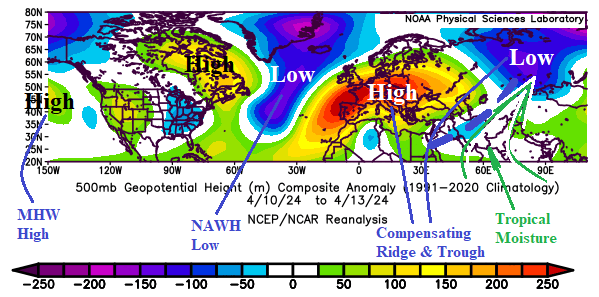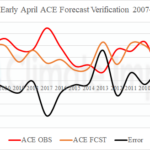
Surprisingly, April ACE Forecasts are not that Accurate
04/09/2024, 2:39 pm EDT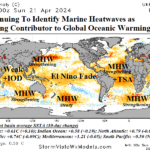
The Influence of Marine Heatwaves on Record Warm Global SST
04/23/2024, 3:58 am EDTExecutive summary: Extreme weather events or climate regimes are often blamed on climate change (or global warming). However, rarely are the weather/climate synoptics causing the event identified and reviewed. An attempt to identify the catalyst to recent historic flooding in the Southern Ural region of Russia to Northern Kazakhstan and adding Dubia well to the south is provided. Certainly, an eastward progression of the convective phase of the Madden Julian oscillation through East Africa helped cause this event. However, characteristic of modern-day climate change, the semi-permanent upper trough over the North Atlantic associated with the North Atlantic warm hole compensated for by an amplified subtropical ridge over Southern Europe set the stage for a downstream intense low-pressure trough causing the historic rain, ice, and snow melt, and damaging widespread flooding from Southern Russia to the United Arab Emirates in recent days.
Discussion: Since the mid-to-late 1990’s, the North Atlantic basin has warmed as indicated by the emergence of the warm phase Atlantic multi-decadal oscillation (+AMO). The persistence and increasing strength of +AMO (Fig. 1) has caused the atmosphere to warm, most evident in the polar region. The high latitude warming is causal to the constriction of the polar ice cap.
More recently, the accelerating (atmospheric) warmth has caused an increase in speed of snow and ice melt during spring and early summer across Northeast Canada and especially Greenland. The increasing fresh water melt to the south of Greenland during the past decade has caused a semi-permanent stratified cool layer of water to pool south of Greenland (Fig. 2) referred to by climate scientists as the North Atlantic warm hole (NAWH).
The large pool of chilly water surrounded by anomalous warmth has caused the atmosphere to cool and trigger formation of a semi-permanent upper trough. At times, the trough is extremely amplified and causes compensating upper-level high pressure ridge areas upstream on the eastern North America coast and downstream in parts of Europe (Fig. 3). The residual ridge areas are often as amplified and create further upstream/downstream troughing. This set of circumstances accelerated by a transient Madden Julian oscillation (MJO) across tropical Africa caused the ongoing flooding in the Southern Ural/Northern Kazakhstan region extending southwestward to Dubai (Fig. 4).
Another complication factor, almost always present when excessive rainfall events occur, were tropical influences. Specifically, the vast warmer than normal western tropical Indian Ocean (Fig. 5) characteristic of lingering positive phase Indian Ocean dipole (+IOD). The warmer than normal tropical waters add moisture to the low-level atmosphere. The upper trough causing the flooding rains into the Southern Ural region entrained some of that low-level atmosphere moisture well to the south to cause the excessive rainfall. This same mechanism also contributed to recent flood in Dubai and the general wetter than normal climate of late across Oman and United Arab Emirates.
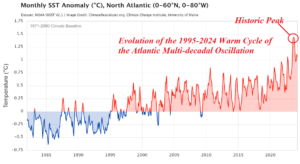
Fig. 1: The warm cycle of the Atlantic multi-decadal oscillation, born in the mid-to-late 1990’s has reached record level warmth during the past 6-7 months.

Fig. 2: An example of the North Atlantic warm hole, frequently in-place during the past decade. The example shown is from July 2015.

Fig. 3: The 2014-23 upper air (500 MB anomaly) climatology driven by the upper trough across the NAWH and upper ridge in the Northeast Pacific across a semi-permanent marine heat wave (MHW).
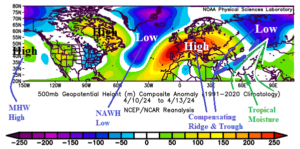
Fig. 4: The upper air pattern leading to the Southern Ural/Northern Kazakhstan historic flooding to Dubai flooding. The upper trough over the North Atlantic warm hole was compensated for by an equally amplified upper ridge over Southern Europe during April 10-13, 2024. Downstream, an amplified trough entraining tropical moisture from the warmer than normal western Indian Ocean tropics caused the excessive flooding event. Certainly, a transient Madden Julian oscillation across tropical Africa helped.
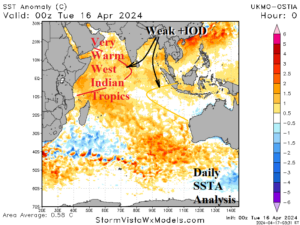
Fig. 5: The warmer than normal western Indian Ocean tropics provided above normal low-level atmosphere moisture entrained into an upper trough extending to the Ural Mountains/Kazakhstan in recent days.
![Climate-Impact-Company-logo-sm[1]](https://climateimpactcompany.com/wp-content/uploads/2023/08/Climate-Impact-Company-logo-sm1.png)
